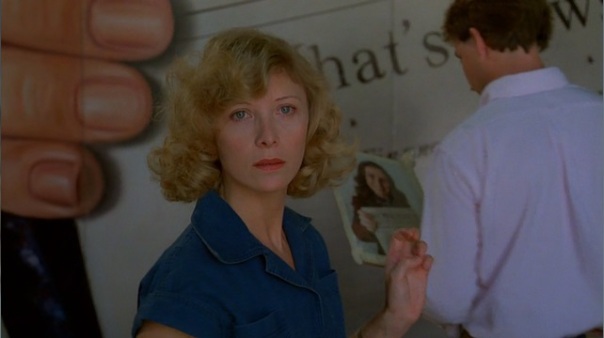Blog Archives
Paris, Texas (1984)

Harry Dean Stanton
We see wide open desert scorched by the sun. Powder blue sky littered with clouds stretching down to the horizon.
We hear an eerie, wavering droning, drifting in the ether. Then a quivering steel guitar slides into the mix.
We see a man wandering through the bright wasteland. The sound of his footsteps barely disturbs the silence.
The bleached colors of this vast landscape are rendered with striking clarity by cinematographer Robby Müller. The trembling metallic tones that hang in the air are played by Ry Cooder. And the haggard man staggering through this barren emptiness is another one of Wim Wenders’ lonely drifters.
Early in his career, Wenders made many movies about people wandering aimlessly from place to place. Alice in the Cities, Kings of the Road, The American Friend and others focus on lonely souls who feel cut off from the world around them. They don’t have families or friends. They don’t have a home. They find themselves taking off on melancholy journeys, sometimes without even knowing where they’re going. Wenders’ early work is filled with images of solitary people surrounded by silent, empty spaces.

Dean Stockwell
Which is pretty much the exact opposite of what you find in the plays of Sam Shepard, who co-wrote Paris, Texas. The stage, by its nature, generally brings people together in a compact space, and the dysfunctional families of pieces like True West and Curse of the Starving Class fill that space with bitter conflict. Shepard’s characters are forced to deal with each other, whether they like it or not, generally resulting in lively, bruising drama.
So Wenders and Shepard would seem to be an unlikely pair, and the process of writing Paris, Texas was long and complicated. Shooting began with an incomplete script, and the two men were continually rethinking the shape of the film, unsure even of how it was going to end. L. M. Kit Carson was brought in to help shape the final version. Apparently creating the film was an open-ended, collaborative process, and no one quite knew where they’d end up.
It may be the difference in the ways Wenders and Shepard approach their work that gives the film its quiet tension. The opening pulls us in with the mystery of Travis, a solitary, sunburned man walking doggedly across the desert. When his brother Walt shows up to take him back to LA, Travis doesn’t say a word, and we wonder if he’ll ever speak again. After some time recovering in the stillness of the suburbs, Travis seems to come around, but then the question is, will his young son ever open up to him? Even as the end draws near, we never know where the film is going, and at the conclusion there are plenty of things left unresolved.

Harry Dean Stanton and Nastassja Kinski
Travis is probably the best part Harry Dean Stanton ever had, and he plays it beautifully. Starting as a spaced-out, scraggly wanderer who seems cut off from everything around him, he slowly reconnects with reality. Recuperating at his brother’s house he’s like a child rediscovering the world, but there’s always a sense of pain buried inside. One of the film’s most moving moments is a brief scene where he’s walking across a freeway overpass. A haggard, angry man stands on the pavement, shouting nonsense at the cars speeding by below. As Travis passes by, he reaches out and pats the man gently on the shoulder. He knows what it’s like to be lost.
Stanton gets strong support from the other actors in the cast, which includes Dean Stockwell, Aurore Clément and Nastassja Kinski. Hunter Carson does a fine job as Travis’ young son. In Wenders’ films it’s not just the words that matter, it’s the space between the words. One of the film’s strengths is that the actors make the silences as expressive as the dialogue.

Aurore Clement
The structure of Paris, Texas has a beautiful simplicity. We start in the vast landscapes of the American Southwest, then travel to the comfortable confines of suburban LA, then, at the end, back to the wide open spaces. Art director Kate Altman gives Wenders and Müller the bedrooms, barrooms and rundown roadside concerns that make up the physical and emotional landscape for this story of shifting relationships. Having worked with Wenders on a number of films, editor Peter Przygodda understands the director’s unique sense of timing. Paris, Texas moves at its own pace, always allowing the audience to observe the actors, experience the landscapes. And in the same way, Cooder’s music doesn’t tell the audience how to feel about the action. Instead he allows each cue to grow out of the scene’s emotional tone. The wistful, lilting Canción mixteca is used as a recurring theme. This haunting melody, with its words expressing a painful longing to go back home, sums up the ache in Travis’ heart. But for him, going home isn’t about returning to the place he came from. It’s about finding a way to heal the family that he tore apart.
Paris, Texas may have been a summing up for Wenders, a turning point in his career. While his later films still deal with isolation and loneliness, from this point on his characters start trying to connect with others. In Wings of Desire and The End of Violence we see them reaching out to embrace the world, while The Buena Vista Social Club and Pina are about groups of people who come together to share their joy in music and dance.
In his youth, Wenders seemed to be wondering if love even existed. These days, he’s sure it’s out there somewhere. Maybe it’s just a matter of being open to it.
